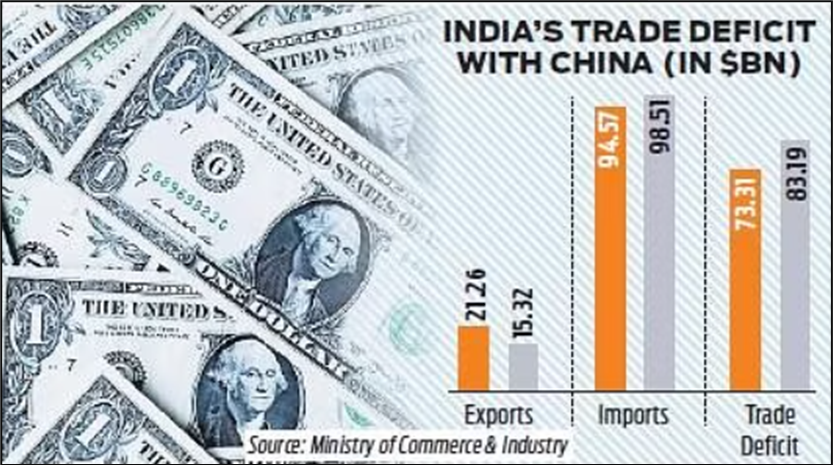Despite various government interventions, the Trade deficit with Countries like China is expanding. Examine the persistent vulnerabilities in the Indian Economy exposed by geopolitical shifts and the escalating trade deficit with China.
| Structure of Answer
Introduction · Briefly explain India’s growing trade deficit with China. Body · Mention Vulnerabilities in the Indian Economy and Governments interventions · Mention Geopolitical Shifts and Escalating Trade Deficit with China · Mention Measures Addressing the Vulnerabilities in Indian Economy Conclusion · Mention need for a comprehensive approach to ensure India’s resilient economic growth in the dynamic global scenario. |
Answer–
India’s economic landscape faces challenges amid geopolitical shifts and a growing trade deficit with China. Despite government initiatives, the trade imbalance persists, with the deficit reaching $83.1 billion in the fiscal year 2022-23, marking a substantial 13.2% increase from the 2021-2022.
Source: Indian Express
Persistent Vulnerabilities in the Indian Economy and Governments interventions
- Trade Imbalance: India’s heavy reliance on imports, particularly from China, has resulted in an expanding trade deficit. Initiatives like the Atmanirbhar Bharat Abhiyan aimed to reduce dependency, but challenges persist due to structural issues.
- Industrial Decline: The decline in industrial growth rates, exacerbated by disruptions in the supply chain, hampers India’s ability to meet domestic demands. Government initiatives to promote domestic manufacturing, such as the Production Linked Incentive (PLI) scheme, aim to revitalize the industrial sector.
- Foreign Direct Investment (FDI) Challenges: The declining FDI to GDP ratio reflects challenges in attracting foreign investment, limiting economic growth. Despite policy measures to attract FDI, the ratio fell from 6% in 2008 to 2.4% in 2022, indicating a need for more robust strategies.
- Infrastructure Constraints: India’s infrastructure bottlenecks, such as inefficient ports and logistics networks, hinder its ability to export competitively and contribute to trade deficits.
- Limited Product Innovation: Indian manufacturing sector faces a deficiency in product innovation, hindering its competitiveness on the global stage, restricting the export potential of Indian companies, preventing them from offering high-value, distinctive products. Initiatives like “One District One Product” aim to boost local manufacturing, but the deficit persists.
Geopolitical Shifts and Escalating Trade Deficit with China
- Structural Trade Imbalance: India’s economic frailty is exacerbated by a structural trade imbalance, with China accounting for a significant portion of imports. As of 2023, China contributes to 15%-16% of India’s imports, with a persistent trade deficit.
- Trade Policy Challenges: Despite efforts to curb imports through initiatives like Atmanirbhar Bharat, policy challenges and the need for critical Chinese inputs have led to resurgence in imports. The trade deficit with China continues to rise, reflecting the challenges in reshaping trade policies.
- Global Supply Chain Disruptions: The COVID-19 pandemic-induced disruptions in global supply chains have exposed India’s vulnerabilities to external shocks. The decline in industrial growth rates, especially in capital goods, showcases the impact of supply chain disruptions.
- Oil and Food Vulnerabilities: Geopolitical shifts and global uncertainties have highlighted India’s susceptibility to oil and food shocks, affecting economic stability. The Finance Ministry’s Monthly Economic Review in September 2023 acknowledges these weaknesses.
- Unprecedented fall in Fixed Capital Formation: Geopolitical shifts contributed to a decline in India’s gross fixed capital formation, from 34.3% in 2011-12 to 28.9% in 2021-22.
Measures Addressing the Vulnerabilities
- Diversification of Trade Partners: Actively pursue trade partnerships with other nations to reduce dependence on a single trading partner. Example: Strengthening ties with countries in Southeast Asia, Africa, and Latin America.
- Enhancing Domestic Industrial Competitiveness: Implementing policies to enhance the competitiveness of domestic industries. Example: Providing financial incentives, infrastructure support, and skill development.
- Strategic Foreign Direct Investment (FDI) Policies: Develop targeted FDI policies to attract investments in key sectors for economic growth. Example: Offering incentives and ease of doing business to attract foreign investors.
- Revitalizing Public Sector: Undertake reforms in the public sector to make it more dynamic and contribute effectively to economic growth. Example: Implementing measures to enhance efficiency and accountability in public sector undertakings.
India’s economic vulnerabilities, underscored by geopolitical shifts and an expanding trade deficit with China, necessitate a comprehensive approach. The government’s efforts, though notable, require further refinement, especially in promoting innovation, diversifying trade relations, and transparent financial management. Embracing a multifaceted strategy will not only address current challenges but position India for resilient and sustained economic growth in the dynamic global scenario.




